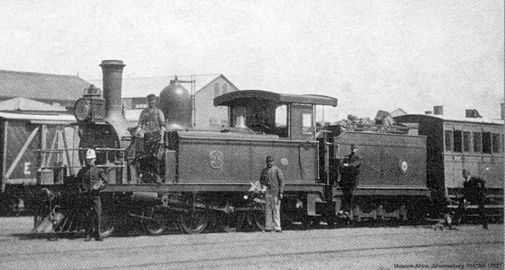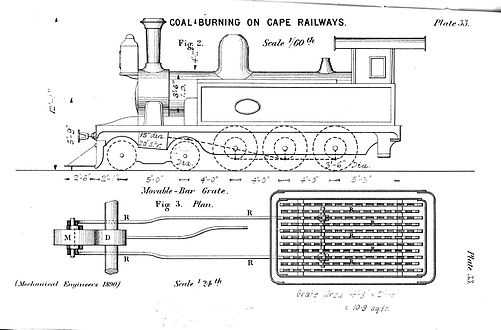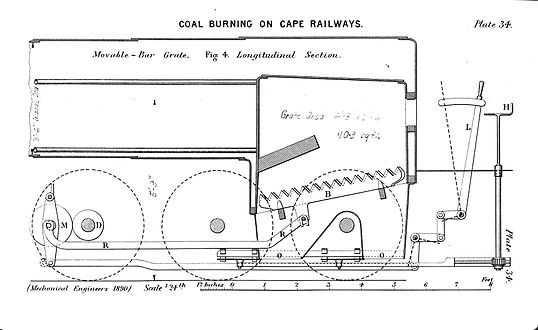CGR 4th Class 4-6-0TT 1880
| CGR 4th Class 4-6-0TT 1880 to South African Class 04 4-6-0TT 1880 | |
|---|---|
|
No. E29 on a passenger train, c. 1886 | |
| Type and origin | |
| Power type | Steam |
| Designer | Cape Government Railways |
| Builder | Robert Stephenson and Company |
| Serial number | 2361-2366, 2385-2390, 2431-2436 |
| Build date | 1879-1880 |
| Total produced | 18 |
| Specifications | |
| Configuration | 4-6-0 "Ten-wheeler" (USA) |
| Gauge | 3 ft 6 in (1,067 mm) Cape gauge |
| Leading wheel diameter | 27 1⁄2 in (699 mm) |
| Driver diameter | 38 in (965 mm) |
| Wheelbase |
8 ft (2.438 m) drivers 5 ft (1.524 m) bogie 16 ft 10 in (5.131 m) engine 8 ft (2.438 m) tender 35 ft 2 7⁄8 in (10.741 m) total |
| Length | 43 ft 4 7⁄8 in (13.230 m) over couplers |
| Height | 12 ft (3.658 m) |
| Axle load | 8 14⁄20 long tons (8.8 t) middle driver |
| Weight on drivers | 23 18⁄20 long tons (24.3 t) |
| Locomotive weight | 32 14⁄20 long tons (33.2 t) w/o |
| Tender weight | 23 2⁄20 long tons (23.5 t) w/o |
| Locomotive and tender combined weight | 55 16⁄20 long tons (56.7 t) w/o |
| Tender type |
Three axle 36 inches (914 mm) wheels |
| Fuel type | Coal |
| Fuel capacity | 6 long tons (6.1 t) |
| Water capacity | 1,675 imp gal (7,610 l; 2,012 US gal) |
| Boiler |
10 ft 1 in (3.073 m) length inside 5 ft 11 in (1.803 m) pitch |
| Boiler pressure | 140 psi (970 kPa) |
| Firegrate area | 11.7 sq ft (1.087 m2) |
| Heating surface: – Tubes | 688 sq ft (63.917 m2) |
| – Firebox | 65 sq ft (6.0 m2) |
| – Total | 753 sq ft (70.0 m2) |
| Cylinders | Two |
| Cylinder size |
15 in (381 mm) bore 20 in (508 mm) stroke |
| Valve gear | Stephenson |
| Performance figures | |
| Tractive effort | 11,250 lbf (50 kN) at 75% pressure |
| Career | |
| Operator(s) |
Cape Government Railways South African Railways |
| Class | CGR 4th Class, SAR Class 04 |
| Number in class | 18 |
| Number(s) | M34-M39, M50-M55, E27-E32 |
| Delivered | 1880-1881 |
| First run | 1880 [1][2] |
The CGR 4th Class 4-6-0TT of 1880 is a South African steam locomotive from the pre-Union era in the Cape Colony.
In 1880 and 1881 the Cape Government Railways placed eighteen 4th Class 4-6-0 tank-and-tender locomotives in mainline service on its Midland System working out of Port Elizabeth and Eastern System working out of East London. Four of these locomotives were still in service to come onto the South African Railways roster in 1912.[1]
Manufacturer
Increasing traffic and heavier loads on the Cape Government Railways (CGR) lines into the interior, from Port Elizabeth on the Cape Midland System and East London on the Cape Eastern System, led to a requirement for larger and more powerful locomotives by the late 1870s. The 4th Class 4-6-0 tank-and-tender locomotive was designed by Michael Stephens, at that stage the Locomotive Superintendent of the Western System in Cape Town, and six locomotives were ordered from Robert Stephenson and Company in 1879. These were delivered to the Midland System in 1880, numbered in the range from M34 to M39.[1][2]
They were followed by two more batches of six from the same manufacturer. The second batch was delivered to the Eastern System in 1880 and 1881, numbered in the range from E27 to E32, and the last batch in 1881 once again to the Midland System, numbered in the range from M50 to M55.[2]
Characteristics
These locomotives, which used Stephenson valve gear and had coupled wheels of 38 inches (965 millimetres) diameter, were intended for freight work. All the locomotives were delivered with optional tenders and depending on the task at hand and the distance involved, they could be used in either the tank engine or the tank-and-tender configuration. To facilitate easy uncoupling from the tender and coupling to rolling stock while working as a tank engine, the engine-to-tender couplings were the standard bell couplers that were in use at the time.[1]
Since the engine did not have a coal bunker, photographs of a locomotive working in the tank engine configuration sometimes show the engine with a bag of coal slung onto the side tanks or stowed on the running boards. These locomotives retained their side-tanks throughout their working lives.[1]
Modifications
.jpg)
J.D. Tilney, the Eastern System's Locomotive Superintendent, carried out many experiments on some of these 4th Class locomotives. One of the modifications introduced by Tilney was an extended smokebox to make room for a very efficient spark arrester constructed of wire mesh. Several locomotives on the Eastern and Midland systems were altered to incorporate these spark arresters, as shown in the photograph alongside of no. 450 with an extended smokebox at Port Elizabeth.[1]
Another modification involved modifying the boilers and frames to accommodate oscillating firebars and larger fireboxes in order to overcome the problems associated with the low-grade local coal from the Cyphergat collieries. Mechanical firegrate shaking was accomplished by means of a collar on the front coupled axle that could engage a roller with eccentrically mounted connecting rods to the oscillating firebars. The drawings to illustrate the operation of the oscillating firebars were published in Mechanical Engineers in 1890.[1][3]
Service
Cape Government Railways
At the time the 4th Class entered service, the Eastern System's lines were open to King William's Town and approaching Queenstown, with the latter being opened on 5 May 1880. Those of the Midland System were completed to Graaff Reinet and Cookhouse respectively.[4]
All these locomotives were renumbered more than once during their service lives on the CGR. By 1886 the system prefixes were done away with and the Midland System's locomotives were all renumbered by replacing the letter prefix M with the numeral 1. By 1888 the six Eastern System locomotives were renumbered into the 600 number range. The Midland System locomotives were renumbered twice more, into the 200 number range by 1890 and into the 400 number range by 1899.[1][2]
By 1899 the first batch of six locomotives of the Midland System were no longer reflected in the locomotive register, and by 1904 all six of the Eastern System were gone from the register as well.[1][2]
South African Railways
The Union of South Africa was established on 31 May 1910, in terms of the South Africa Act. One of the clauses in the Act required that the three Colonial Government railways, the CGR, the Natal Government Railways and the Central South African Railways, also be united under one single administration to control and administer the railways, ports and harbours of the Union. While the South African Railways (SAR) came into existence in 1910, the actual classification and renumbering of all the rolling stock of the three constituent railways required careful planning and was only implemented with effect from 1 January 1912.[4][5]
By 1912 four locomotives survived, numbers 451 to 454. They were considered obsolete by the SAR, designated Class 04 and renumbered by having the numeral 0 prefixed to their existing numbers.[5]
Works numbers
The works numbers, year built, original numbers and renumberings of the Cape 4th Class of 1880 are set out in the table.[1][2][5]
Works no. |
Year blt. |
Orig. no. |
1886 no. |
1888 no. |
1890 no. |
1899 no. |
1904 no. |
SAR no. |
|---|---|---|---|---|---|---|---|---|
| 2361 | 1879 | M34 | 134 | 134 | 234 | |||
| 2362 | 1879 | M35 | 135 | 135 | 235 | |||
| 2363 | 1879 | M36 | 136 | 136 | 236 | |||
| 2364 | 1879 | M37 | 137 | 137 | 237 | |||
| 2365 | 1879 | M38 | 138 | 138 | 238 | |||
| 2366 | 1879 | M39 | 139 | 139 | 239 | |||
| 2385 | 1880 | E27 | 27 | 645 | 645 | 645 | ||
| 2386 | 1880 | E28 | 28 | 646 | 646 | 646 | ||
| 2387 | 1880 | E29 | 29 | 647 | 647 | 647 | ||
| 2388 | 1881 | E30 | 30 | 648 | 648 | 648 | ||
| 2389 | 1881 | E31 | 31 | 649 | 649 | 649 | ||
| 2390 | 1881 | E32 | 32 | 650 | 650 | 650 | ||
| 2431 | 1881 | M50 | 150 | 150 | 250 | 450 | 450 | |
| 2432 | 1881 | M51 | 151 | 151 | 251 | 451 | 451 | 0451 |
| 2433 | 1881 | M52 | 152 | 152 | 252 | 452 | 452 | 0452 |
| 2434 | 1881 | M53 | 153 | 153 | 253 | 453 | 453 | 0453 |
| 2435 | 1881 | M54 | 154 | 154 | 254 | 454 | 454 | 0454 |
| 2436 | 1881 | M55 | 155 | 155 | 255 | 455 | 455 | |
See also
- CGR 4th Class 4-6-0TT 1882
- CGR 4th Class 4-6-0TT 1884
- The 4-6-0 wheel arrangement
- South African locomotive history
- List of South African locomotive classes
References
|
- ↑ 1.0 1.1 1.2 1.3 1.4 1.5 1.6 1.7 1.8 1.9 Holland, D.F. (1971). Steam Locomotives of the South African Railways, Volume 1: 1859-1910 (1st ed.). Newton Abbott, Devon: David & Charles. pp. 32–34. ISBN 978-0-7153-5382-0.
- ↑ 2.0 2.1 2.2 2.3 2.4 2.5 C.G.R. Numbering Revised, Article by Dave Littley, SA Rail May–June 1993, pp. 94-95.
- ↑ Coal Burning on Cape Railways, Mechanical Engineers 1890, Plates 33 and 34.
- ↑ 4.0 4.1 The South African Railways - Historical Survey. Editor George Hart, Publisher Bill Hart, Sponsored by Dorbyl Ltd., Published c. 1978, pp. 12, 25.
- ↑ 5.0 5.1 5.2 Classification of S.A.R. Engines with Renumbering Lists, issued by the Chief Mechanical Engineer’s Office, Pretoria, January 1912. (Reprinted in April 1987 by SATS Museum, R.3125-6/9/11-1000)


